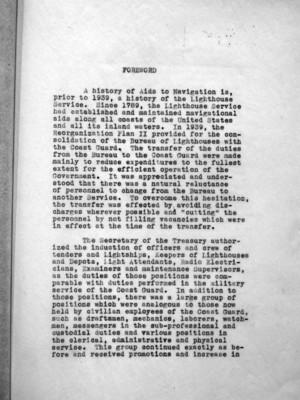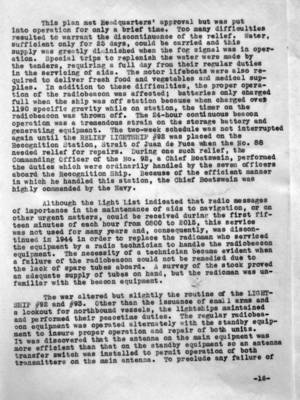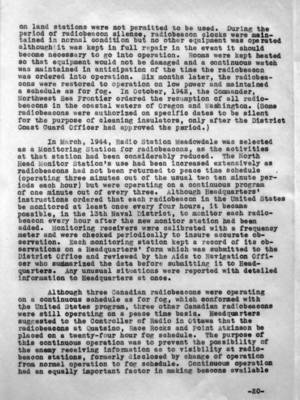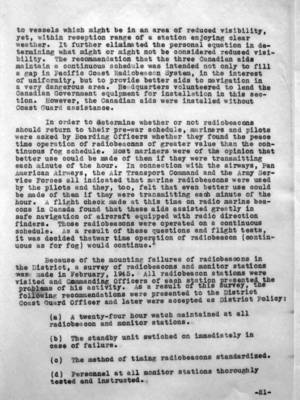Pages That Mention AIDS TO NAVIGATION
Coast Guard District narrative histories 1945
16
FOREWORD
A history of Aids to Navigation is, prior to 1939, a history of the Lighthouse Service. Since 1789, the Lighthouse Service had established and maintained navigational aids along all coasts of the United States and all its inland waters. In 1939, the Reorganization Plan II provided for the consolidation of the Bureau of Lighthouses with the Coast Guard. The transfer of the duties from the Bureau to the Coast Guard were made mainly to reduce expenditures to the fullest extent for the efficient operation of the Government. It was appreciated and understood that there was a natural reluctance of personnel to change from the Bureau to another Service. To overcome this hesitation, the transfer was effected by avoiding discharges wherever possible and "cutting" the personnel by not filling vacancies which were in effect at the time of the transfer.
The Secretary of the Treasury authorized the induction of officers and crew of tenders and Lightships, Keepers of Lighthouses and Depots, Light Attendants, Radio Electricians, Examiners and Maintenance Supervisors, as the duties of those positions were comparable with duties performed in the military service of the Coast Guard. In addition to those positions, there was a large group of positions which were analogous to those now held by civilian employees of the Coast Guard, such as draftsmen, mechanics, laborers, watchmen, messengers in the sub-professional and custodial duties and various positions in the clerical, administrative and physical service. This group continued exactly as before and received promotions and increase in
35
This plan met Headquarters' approval but was put into operation for only a brief time. Too many difficulties resulted to warrant the discontinuance of the relief. Water, sufficient only for 25 days, could be carried and this supply was greatly diminished when the fog signal was in operation. Special trips to replenish the water were made by the tenders, requiring a full day from their regular duties in the servicing of aids. The motor lifeboats were also required to deliver fresh food and vegetables and medical supplies. In addition to these difficulties, the proper operation of the radiobeacon was affected; batteries only charged full when the ship was off station because when charged over 1190 specific gravity while on station, the timer on the radiobeacon was thrown off. The 24-hour continuous beacon operation was a tremendous strain on the storage battery and generating equipment. The two-week schedule was not interrupted again until the RELIEF LIGHTSHIP #92 was placed on the Recognition Station, Strait of Juan de Fuca when the No. 88 needed relief for repairs. During one such relief, the Commanding Officer of the No. 92, a Chief Boatswain, performed the duties which were ordinarily handled by the seven officers aboard the Recognition Ship. Because of the efficient manner in which he handled this station, the Chief Boatswain was highly commended by the Navy.
Although the Light List indicated that radio messages of importance in the maintenance of aids to navigation, or on other urgent matters, could be received during the first fifteen minutes of each hour from 0800 to 2015, this service was not used for many years and, consequently, was discontinued in 1944 in order to replace the radioman who serviced the equipment by a radio technician to handle the radiobeacon equipment. The necessity of a technician became evident when a failure of the radiobeacon could not be remedied due to the lack of spare tubes aboard. A survey of the stock proved an adequate supply of tubes on hand, but the radioman was unfamiliar with the beacon equipment.
The war altered but slightly the routine of the LIGHTSHIP #92 and #93. Other than the issuance of small arms and a lookout for the northbound vessels, the lightships maintained and performed their peacetime duties. The regular radiobeacon equipment was operated alternately with the standby equipment to insure proper operation and repair on both units. It was discovered that the antenna on the main equipment was more efficient than that on the standby equipment so an antenna transfer switch was installed to permit operation of both transmitters on the main antenna. To preclude any failure of
37
The early conception of the mariners, that all aids to navigation must be received by the normal senses of sight and sound, was radically changed by the development of the radiobeacon system which has, since its inception in 1921, become recognized as a most important innovation for increased safety for mariners. As radio signals are not obscured by fog, wind, rain, snow or temperature changes, and bearings may be taken at great distances far beyond the horizon, the radiobeacon had great advantages over previous types of navigational aids. Proof of its efficiency lay in the fact that since its inception approximately a quarter of a century ago, the radiobeacon system was adopted by all maritime nations and direction finders were developed to fit not only the requirements of large ocean liners, but small pleasure craft and fisherman's vessels as well.
At the time of the consolidation of the Lighthouse Service and the Coast Guard, the Seattle District operated nine-land-based radiobeacons and four radiobeacons on the lightships at Swiftsure Bank, Umatilla Reef and the entrance to the Columbia River. Two beacons were under construction at Destruction Island (completed in 1943) and at Willapa Bay (completed in 1941). Two more radiobeacons were authorized in 1842, one at Cape Flattery (Tatoosh Island) and one at West Point. In the middle of 1945, the radiobeacon at Ediz Hook was established, bringing the total number of District radiobeacons to 18. However, at the onset of the war, the Navy removed the lightships from Umatilla Reef and Swiftsure Bank thus leaving only 16 beacons in operation. Of these 16, one was maintained by the RELIEF LIGHTSHIP and used alternately on the Columbia River station.
In an effort to increase, to even a greater degree, the efficiency of the radiobeacon system throughout the United States, headquarters urged that a monitor system be developed and put into operation in each District. Subsequently, a monitor station was established at North head Radio Station which checked the performance of all District radiobeacons. Between 0800 to 1100 and 1500 to 1900 daily, each radiobeacon was monitored, the time for the check being staggered to insure a truer picture of the various beacons' performance. Outlying stations were notified daily of all failures or defects in the radiobeacons' operation. These reports were a District innovation and were not required by Headquarters but were merely another measure adopted by the District Coast Guard Office for increased efficiency in the District system.
-18-
39
on land stations were not permitted to be used. During the period of radiobeacon silence, radiobeacon clocks were maintained in normal condition but no other equipment was operated although it was kept in in full repair in the event it should become necessary to go into operation. Rooms were kept heated so that equipment would not be damaged and a continuous watch was maintained in anticipation of the time the radiobeacon was ordered into operation. Six months later, the radiobeacons were restored to operation on low power and maintained a schedule as for fog. In October, 1942, the Commander, Northwest Sea Frontier ordered the resumption of all radiobeacons in the coastal waters of Oregon and Washington. (Some radiobeacons were authorized on specific dates to be silent for the purpose of cleaning insulators, only after the District Coast Guard Officer had approved the period.)
In March, 1944, Radio Station Meadowdale was selected as a Monitoring Station for radiobeacons, as the activities at that station had been considerably reduced. The North Head Monitor Station's use had been increased extensively as radiobeacons had not been returned to peace time schedule (operating three minutes out of the usual two ten minute periods each hour) but were operating on a continuous program of one minute out of every three. Although Headquarters' instructions ordered that each radiobeacon in the United States be monitored at least once every four hours, it became possible, in the 13th Navel District, to monitor each radiobeacon every hour after the new monitor station had been added. Monitoring receivers were calibrated with a frequency meter and were checked periodically to insure accurate observation. Each monitoring station kept a record of its observations on a Headquarters' form which was submitted to the District Office and reviewed by the Aids to Navigation Officer who summarized the data before submitting it to Headquarters. Any unusual situations were reproted with detailed information to Headquarters at once.
Although three Canadian radiobeacons were operating on a continuous schedule as for fog, which conformed with the United States program, three other Canadian radiobeacons were still operating on a peace time basis. Headquarters suggested to the Controller of Radio in Ottawa that the radiobeacons at Quatsino, Race Rocks and Point Atkinson be placed on a twenty-four hour fog schedule. the purpose of this continuous operation was to prevent the possibility of the enemy receiving information as to visibility at radiobeacon stations, formerly disclosed by change of operation from normal operation to fog schedule. Continuous operation had an equally important factor in making beacons available
-20-
40
to vessels which might be in an area of reduced visibility, yet, within reception range of a station enjoying clear weather. It further eliminated the personal equation in determining what might or might not be considered reduced visibility. The recommendation that the three Canadian aids maintain a continuous schedule was intended not only to fill a gap in Pacific Coast Radiobeacon System, in the interest of uniformity, but to provide better aids to navigation in a very dangerous area. Headquarters volunteered to lend the Canadian Government equipment for installation in this section. However, the Canadian aids were installed without Coast Guard assistance.
In order to determine whether of not radiobeacons should return to their pre-war schedule, mariners and pilots were asked by Boarding Officers whether they found the peace time operation of radiobeacons of greater value than the continuous fog schedule. Most mariners were of the opinion that better use could be made of them if they were transmitting each minute of the hour. In connection with the airways, Pan American Airways, the Air Transport Command and the Army Service Forces all indicated that marine radiobeacons were used by the pilots and they, too, felt that even better use could be made of them if they were transmitting each minute of the hour. A flight check made at this time on radio marine beacons in Canada found that these aids assisted greatly in safe navigation of aircraft equipped with radio direction finders. Those radiobeacons were operated on a continuous schedule. As a result of these questions and flight tests, it was decided that war time operation of radiobeacon (continuous as for fog) would continue.
Because of the mounting failures of radiobeacons in the District, a survey of radiobeacons and monitor stations was made in February, 1945. All radiobeacon stations were visited and Commanding Officers of each station presented the problems of his activity. As a result of this survey, the following recommendations were presented to the District Coast Guard Officer and later were accepted as District Policy:
(a) A twenty-four hour watch maintained at all radiobeacon and monitor station.
(b) The standby unit swtiched on immediately in case of failure.
(c) The method of timing radiobeacons standardized.
(d) Personnel at all monitor stations thoroughly tested and instructed.
-21-




